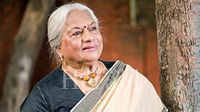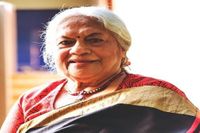Ahmedabad, April 13, 2025 – India mourns the loss of one of its most iconic cultural stalwarts, Kumudini Lakhia, who passed away on April 12, 2025, at the age of 95. A visionary Kathak dancer and choreographer, Lakhia revolutionized Indian classical dance by transforming Kathak from a solo performance into an ensemble-based, modern narrative art form. She breathed her last in Ahmedabad, Gujarat, where she spent decades mentoring students and shaping the Kadamb Centre for Dance and Music, which she founded in 1964.
A Life of Rhythm, Discipline, and Innovation Born on May 17, 1930, in India, Kumudini Lakhia’s journey into the world of dance began at a young age. Her training spanned both the Lucknow and Jaipur gharanas, under stalwarts like Shambhu Maharaj and Sunder Prasad, equipping her with a rare, comprehensive command over Kathak’s diverse stylistic roots. Unlike her contemporaries, Lakhia believed in questioning tradition, not abandoning it, and her work pushed the boundaries of what Kathak could express. “She showed us that classical dance can be both timeless and modern,” said Vaishali Trivedi, her disciple and senior faculty at Kadamb.
Founder of Kadamb Dance Academy: A Vision Beyond Performance In 1964, Lakhia established Kadamb Centre for Dance and Music in Ahmedabad — a space where Kathak was not only taught but explored as a creative, evolving language. Under her mentorship, generations of dancers including Aditi Mangaldas, Parul Shah, and Maulik Shah have carried forward her legacy of innovation, discipline, and artistic courage. Kadamb has also collaborated with musicians, theatre artists, and international dance troupes, placing Ahmedabad on the global cultural map.
Pioneering Choreographies That Changed Kathak Her choreographic masterpieces, such as: Dhabkar (Heartbeat), Yugal (The Pair), Atah Kim (What Next?), and Sam Samvedan, broke away from the linear storytelling typical of classical formats and embraced abstract thought, modern dilemmas, and ensemble spatial design.
National and Global Recognition For her groundbreaking contributions, Kumudini Lakhia was honoured with the Padma Shri in 1987 and the Padma Bhushan in 2010, along with the Sangeet Natak Akademi Award and Kalidas Samman. She represented India at numerous global cultural festivals, and her work is studied in performing arts institutions across Europe, the U.S., and Japan.
Tributes Pour In Tributes from across the arts world and political leadership have begun pouring in: “The passing of Kumudini Lakhia ji is a loss not just to Kathak, but to Indian culture as a whole,” said Prime Minister Narendra Modi in a social media post. “She was an innovator, a teacher, and a torchbearer of our heritage,” said Hema Malini, actress and classical dancer.
Beyond the Stage: A Feminist, Philosopher, and Mentor Lakhia’s influence extended beyond choreography. She was a feminist voice in Indian dance, often highlighting the female gaze, body, and strength in her works. Her philosophy: “Dance is not a museum. It is a mirror — of the times, of the self, and of society.” Even in her 90s, she remained intellectually active, mentoring young choreographers and serving on dance juries.
Final Days and Legacy While she had slowed down physically in recent years, Lakhia continued to choreograph, advise, and inspire. She is survived by a generation of dancers who now carry her torch. Her final public appearance was during a Kathak workshop in January 2025, where she addressed students on “creativity and courage in classical traditions.” Plans are underway for a state-level tribute and cultural homage at Kadamb’s open-air amphitheatre later this week.
An Era Ends, But the Rhythm Remains Kumudini Lakhia’s demise marks the end of an epoch in Indian classical dance, but her legacy will live on — not only through performances, awards, or institutions — but in the hearts, limbs, and spirits of every dancer she touched. She didn’t just teach Kathak. She redefined what it means to move with meaning. As President Droupadi Murmu expressed, “Her contribution in the field of performing arts will be cherished forever.”






